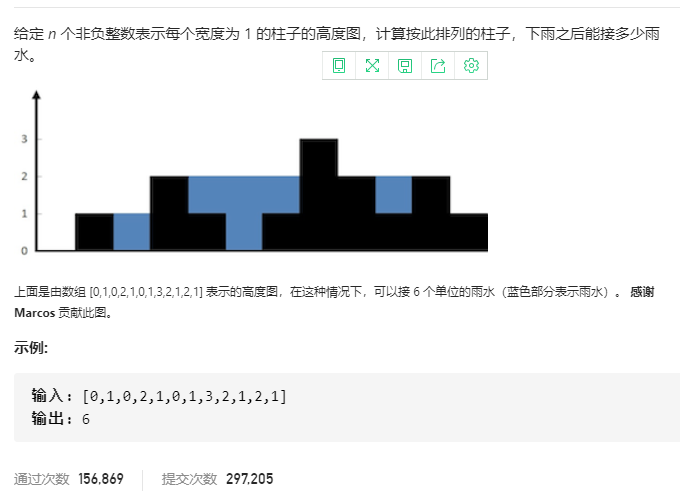LeetCode题解——接雨水
我的LeetCode代码集:https://github.com/cnamep001/LeetCode
原题链接:https://leetcode-cn.com/problems/trapping-rain-water/description/
题目描述:

思路一:利用栈
我们的栈stack中存储的是height数组的索引。如果指针cur指向的height数组中的值小于等于栈顶元素或者栈为空,我们就一直入栈,因此我们栈顶元素索引对应的height数组的值是整个栈中最小的。一旦指针cur指向的height数组中的值超过栈顶的元素索引对应的height数组的值,就代表栈顶元素有一个右边界。由于栈中的元素都是递减的,所以如果存在一个比栈顶元素大的栈中元素,则一定可以确定该横向区域内的盛水量。
时间复杂度是O(n),空间复杂度是O(n)。
实现代码:
package com.m.trapping_rain_water.solution1;
import java.util.Stack;
public class Solution1 {
public int trap(int[] height) {
int n = height.length;
int result = 0;
if (n == 0 || n == 1) {
return result;
}
int cur = 0;
Stack<Integer> stack = new Stack<Integer>();
while (cur < n) {
while (!stack.isEmpty() && height[cur] > height[stack.peek()]) {
int top = stack.pop();
if (stack.isEmpty()) {
break;
}
int distance = cur - stack.peek() - 1;
int tempHeight = Math.min(height[cur], height[stack.peek()]) - height[top];
result += tempHeight * distance;
}
stack.push(cur);
cur++;
}
return result;
}
}
LeetCode解题报告:

思路二:用双指针法
(1)首先,找到能存水的左边界索引left和右边界索引right。
对于左边界索引left是从数组头到数组尾方向看,第一次出现下降趋势的那个索引的位置。
对于右边界索引right是从数组尾到数组头方向看,第一次出现下降趋势的那个索引的位置。
(2)记录左边界和右边界的高度,分别记作leftHeight和rightHeight。显然,雨水数是由较低的边界所决定的。
a.如果leftHeight小于等于rightHeight。
如果此时满足left < right,说明左右边界还没有重合,尝试着令left加1。如果left位置能够存储雨水,则更新结果的值。如果left位置不能存储雨水,说明left位置的高度大于等于leftHeight,这时我们应该进入下一轮循环,更新leftHeight的值。
b.如果leftHeight大于rightHeight
如果此时满足left < right,说明左右边界还没有重合,尝试着令right减1。如果right位置能够存储雨水,则更新结果的值。如果right位置不能存储雨水,说明right位置的高度大于等于rightHeight,这时我们应该进入下一轮循环,更新rightHeight的值。
该思路的时间复杂度是O(n)级别的,空间复杂度是O(1)级别的。
实现代码:
package com.m.trapping_rain_water.solution2;
public class Solution2 {
public int trap(int[] height) {
int n = height.length;
int result = 0;
if (n == 0 || n == 1) {
return result;
}
int left = 0;
while (left < n - 1 && height[left + 1] >= height[left]) {
left++;
}
int right = n - 1;
while (right >= 1 && height[right - 1] >= height[right]) {
right--;
}
while (left < right) {
int leftHeight = height[left];
int rightHeight = height[right];
if (leftHeight <= rightHeight) {
while (left < right) {
left++;
if (height[left] < leftHeight) {
result += leftHeight - height[left];
} else {
break;
}
}
} else {
while (left < right) {
right--;
if (height[right] < rightHeight) {
result += rightHeight - height[right];
} else {
break;
}
}
}
}
return result;
}
}
LeetCode解题报告:

思路三:逐层累加法(会超时)
首先遍历数组得到最高的柱子的高度maxHeight,我们总共需要计算maxHeight层。
计算第i层时,我们需要将柱子的高度减去i,这里i从0开始计数。我们寻找每一层的左边界left和右边界right,在[left, right]之间高度小于等于0处,我们可以令能接的雨水数加1。
这个思路的时间复杂度很明显,是O(maxHeight * n)级别的,其中n为height数组的长度。而对于空间复杂度,我们使用了一个新的数组newHeight记录各柱子高度减去i时的值,因此是O(n)级别的。
实现代码:
package com.m.trapping_rain_water.solution3;
public class Solution3 {
public int trap(int[] height) {
int n = height.length;
int result = 0;
if (n == 0) {
return result;
}
int maxHeight = height[0];
for (int i = 1; i < n; i++) {
if (height[i] > maxHeight) {
maxHeight = height[i];
}
}
int[] newHeight = new int[n];
for (int i = 0; i < maxHeight; i++) {
for (int j = 0; j < n; j++) {
newHeight[j] = height[j] - i;
}
int left = 0;
int right = n - 1;
while (left < n && newHeight[left] <= 0) {
left++;
}
while (right >= 0 && newHeight[right] <= 0) {
right--;
}
for (int j = left; j <= right; j++) {
if (newHeight[j] <= 0) {
result++;
}
}
}
return result;
}
}